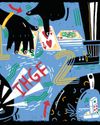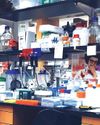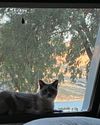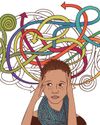
On the afternoon of July 13, 1733, the Spanish ship named the San Pedro left Havana, Cuba. The ship was loaded with silver coins and precious jewels. This was supposed to be a routine trip, transporting goods from the colonies to Spain.
But the San Pedro never completed its voyage. That afternoon, a hurricane roared in. Waves and winds thrashed the ship, breaking it apart. The San Pedro sank, dropping beneath the waves before coming to its final resting place 18 feet (5.5 meters) below. And there the ship sat for more than 200 years.
In the 1960s, divers rediscovered the lost ship, still nestled in its sandy grave 18 feet (5.5 meters) below the warm waters off the Florida Keys. In the ruins of the ship, the divers found a treasure. But it wasn't gold and silver-the Spanish had recovered almost all of those riches long ago. Instead, the divers found the ship transformed into a magnificent marine ecosystem. The wreck of the San Pedro was now a coral reef teeming with life.
Today, the San Pedro is part of the Florida Keys National Marine Sanctuary, a collection of nine shipwrecks off the southern tip of Florida. Once, these sunken ships were barren, lifeless vessels. Today, they all host spellbinding marine ecosystems. They have become artificial coral reefs.
Ecological Succession
The birth of a coral reef is a great example of one of nature's most fundamental and important processes-ecological succession. Ecological succession is the gradual change of species and communities over time. Ecological succession is how an area, once destroyed by a terrible wildfire, recovers and transforms into a lush prairie. It's how a shrubland filled with short, woody plants grows into a towering forest. Or, it can be how a barren shipwreck transforms into a magnificent coral reef.
Denne historien er fra July/August 2023-utgaven av Muse Science Magazine for Kids.
Start din 7-dagers gratis prøveperiode på Magzter GOLD for å få tilgang til tusenvis av utvalgte premiumhistorier og 9000+ magasiner og aviser.
Allerede abonnent ? Logg på
Denne historien er fra July/August 2023-utgaven av Muse Science Magazine for Kids.
Start din 7-dagers gratis prøveperiode på Magzter GOLD for å få tilgang til tusenvis av utvalgte premiumhistorier og 9000+ magasiner og aviser.
Allerede abonnent? Logg på

HOUSE OF CARDS
TRY THE PERFECT EXPERIMENT—AND THEN REFLECT ON HOW IT WENT.

ACCIDENTALLY Delicious
Have you ever been really hungry, but there wasn't much to eat in your kitchen? Did you throw together a bunch of stuff you had on hand and were pleasantly surprised when it tasted good?

IS YOUR SOCIAL MEDIA FEED TOO PERFECT?
EVERYONE'S LIFE CAN APPEAR PERFECT ON SOCIAL MEDIA. On YouTube, Instagram, Snapchat, and similar apps, people tend to share their happiest, most picturesque moments. They carefully compose any text to get the message just right. They use filters and enhancements to glam up images and videos. The app sorts the posts with the most likes and comments to the top. The end result? All you see of others' lives is the best of the best.

Art ALERT!
THE CASE OF THE MASTERPIECE THAT WASN'T

MARYAM ZARINGHALAM
SCIENCE POLICY FELLOW AND WRITER

Lost Cat Treks More Than 800 Miles to Get Home
Rayne Beau (pronounced RANE-BO, as in \"rainbow\") is a two-year-old Siamese cat.

EASY AS ABC
But in number theory, well, it's complicated.

That Wanaka Tree Gets a Companion
\"THAT WANAKA TREE,\" AS IT'S CALLED, IS A FAMOUS WILLOW TREE THAT GROWS OUT OF LAKE WANAKA ON THE SOUTH ISLAND OF NEW ZEALAND.

Two College Students Devise Smart Glasses That Can ID People
YOU'RE WAITING FOR THE SUBWAY WITH A COUPLE OF YOUR FRIENDS.

Two Comb Jellies Can Fuse Their Bodies Together to Become One
COMB JELLIES ARE GELATIN-LIKE AND MOSTLY SEETHROUGH INVERTEBRATES, OR ANIMALS WITHOUT A BACKBONE, THAT FLOAT IN THE OCEAN NEAR SHORE.
